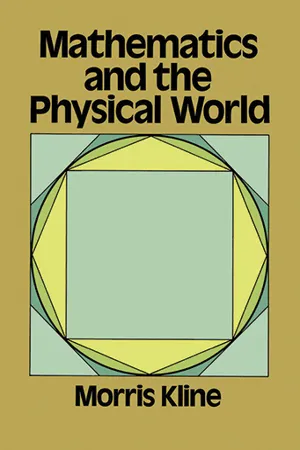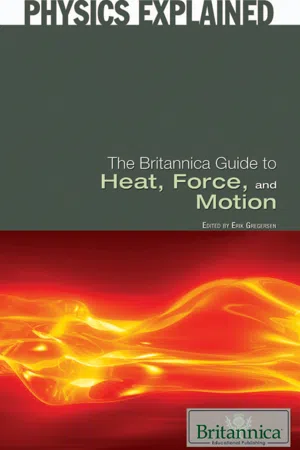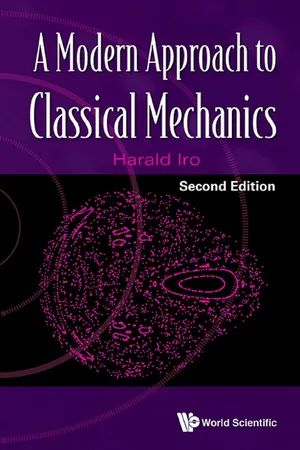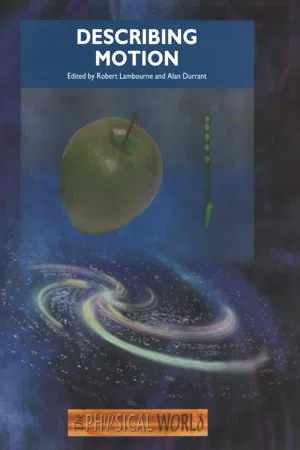Physics
Periodic Motion
Periodic motion refers to the repetitive back-and-forth movement of an object around a central position. This type of motion follows a regular pattern, with the object returning to its original position after a fixed time interval. Examples of periodic motion include the swinging of a pendulum, the vibrations of a guitar string, and the oscillations of a spring.
Written by Perlego with AI-assistance
Related key terms
Related key terms
1 of 4
Related key terms
1 of 3
5 Key excerpts on "Periodic Motion"
- eBook - ePub
- A. L. Stanford, J. M. Tanner(Authors)
- 2014(Publication Date)
- Academic Press(Publisher)
8Oscillations
Publisher Summary
This chapter discusses oscillation, which is a back-and-forth motion over the same path. If an oscillating object executes each cycle, or repetition of its motion, in equal intervals of time, the motion is said to be periodic. The motion of a pendulum of a clock is an example of periodic oscillation. It is particularly instructive to relate the simple harmonic motion of a particle to circular motion. A particle moving in a circular path at constant speed is in Periodic Motion. In particular, the frequency of the oscillation does not depend on the amplitude of the oscillation. This important characteristic of simple harmonic oscillators means that if a mass oscillating is started by extending the spring to which it is attached to any length before releasing it, the system will oscillate at the same frequency. The independence of the frequency or period and the amplitude means that identical oscillators, extended different distances from equilibrium and released simultaneously, will reach the equilibrium position simultaneously.An oscillation is a back-and-forth motion over the same path. If an oscillating object executes each cycle , or repetition of its motion, in equal intervals of time, the motion is said to be periodic . The motion of a pendulum of a clock is an example of periodic oscillation. In this chapter we will concentrate on the simplest form of periodic oscillation, called simple harmonic motion, in which oscillatory motion takes place along a straight line. Simple harmonic motion plays a fundamental role in several areas of physics, and it is associated with several topics that are covered in subsequent chapters of this text.Idealized systems that execute simple harmonic motion are the primary considerations of this chapter. A discussion of quantities that characterize simple harmonic motion will be followed by a detailed kinematic analysis of that kind of motion. Then we will consider the dynamics of ideal oscillators, relating the forces that cause simple harmonic motion to the motion itself. Energy considerations will complete our analysis of idealized oscillators. - eBook - ePub
- Morris Kline(Author)
- 2012(Publication Date)
- Dover Publications(Publisher)
18: THE MATHEMATICS OF OSCILLATORY MOTION Ut tensio, sic vis. —ROBERT HOOKETHE motions of projectiles, of planets, and of light have an obvious importance or attraction, and one would therefore hardly question why men should study these motions. On the other hand, the motion of an object suspended from a spring and bobbing up and down repeatedly seems to offer no more attraction than to while away an idle hour. Of course an idle mind readily becomes the devil’s playground, but we shall tempt the devil.Let us be clear first as to what is different about the motion of objects on springs as compared with the motions we have previously examined. A projectile shot from a cannon traverses its course to the target and stops there. It does not then reverse its motion and return to the cannon. In fact it is apparently so pleased to have completed its motion that it announces its arrival at its destination with a bang. Some motions are never completed but continue indefinitely in one direction. Thus the earth, after completing one revolution around the sun, does not stop and then move in the opposite direction. Projectiles and planets move, so to speak, along one-way streets. On the other hand, the object bobbing up and down in response to the force exerted by the spring travels back and forth endlessly. The object goes nowhere in this oscillatory motion; yet the study of such motions has carried man far in his scientific travels.Historically, the investigation of oscillatory motions was motivated by the desire to improve methods of telling time. The primary standard of time is, of course, the motion of the earth around the sun, but this natural clock is not particularly useful in the daily affairs of man. In the seventeenth century the need to measure small periods of time accurately for the purpose of telling longitude at sea caused scientists to search for increasingly accurate clocks. The search resulted in some major successes that were at least as valuable for the advancement of mathematics and the study of other phenomena of nature, such as light and sound, as they were for the specific problem of measuring time. - eBook - ePub
- Britannica Educational Publishing, Erik Gregersen(Authors)
- 2010(Publication Date)
- Britannica Educational Publishing(Publisher)
θ is equal to 0.296, an error of less than 2 percent. For smaller angles, of course, the error is appreciably smaller.The problem was also treated as if all the mass of the pendulum were concentrated at a point at the end of the cable. This approximation assumes that the mass of the bob at the end of the cable is much larger than that of the cable and that the physical size of the bob is small compared with the length of the cable. When these approximations are not sufficient, one must take into account the way in which mass is distributed in the cable and bob. This is called the physical pendulum, as opposed to the idealized model of the simple pendulum. Significantly, the period of a physical pendulum does not depend on its total mass either.The effects of friction, air resistance, and the like have also been ignored. These dissipative forces have the same effects on the pendulum as they do on any other kind of harmonic oscillator. They cause the amplitude of a freely swinging pendulum to grow smaller on successive swings. Conversely, in order to keep a pendulum clock going, a mechanism is needed to restore the energy lost to dissipative forces.CIRCULAR MOTIONConsider a particle moving along the perimeter of a circle at a uniform rate, such that it makes one complete revolution every hour. To describe the motion mathematically, a vector is constructed from the centre of the circle to the particle. The vector then makes one complete revolution every hour. In other words, the vector behaves exactly like the large hand on a wristwatch, an arrow of fixed length that makes one complete revolution every hour. The motion of the point of the vector is an example of uniform circular motion, and the period T of the motion is equal to one hour (T = 1 h). The arrow sweeps out an angle of 2π radians (one complete circle) per hour. This rate is called the angular frequency and is written ω = 2πh-1 - eBook - ePub
- Harald Iro(Author)
- 2015(Publication Date)
- WSPC(Publisher)
Fig. 3.4 ). By conservation of energy (3.7),(where E = V (x1 ) = V (x2 )), and hence the velocity at time t, 0 ≤ t ≤ t1 , isFigure 3.5: The trajectories in phase space for different types of motion in the potential V (x).The motion of the particle from x1 to x2 is the exact reverse of this, which is a consequence of the invariance of the equation of motion (3.5) under time reversal. The time required to go from x2 to x1 is therefore half the total time τ required to get back to where it began, namely x2 :After time τ, the motion repeats itself, and one hasτ is called the period. All one-dimensional, bounded motion is periodic.In general, the period τ, and consequently the oscillation frequency ω := 2π/τ, depend on the energy chosen: τ = τ(E). Since the motion is periodic, the trajectories in phase space are closed (cf. Fig. 3.5 ). The periodicity of the motion suggests that a Fourier series expansion of x(t) is close at hand. Indeed, this constitutes the first step in the method of harmonic analysis.The point xequfor which V (x) has a minimum (Fig. 3.4 ) is called the equilibrium position,No net force acts at xwhere the quantityequ, and vanishes. Expanding V (x) about the equilibrium position xequ, we haveis positive (and therefore ω0 real), as seen in Fig. (3.4). For small energies (i.e. energies close to V (xequ)), one can use the harmonic approximation, in which all terms after the quadratic term in the expansion (3.12) of V (x) are omitted. Shifting the coordinate system such that xequis the new origin – i.e. setting xequ= 0 – one obtains the equation of motion:The point mass oscillates (see Section 3.3.3 below) about the equilibrium with frequency ω0 . The frequency ω0 is independent of the energy E and is determined only by the curvature of the potential in the vicinity of xequ.Unbounded motion
Motion along the positive x-axis is unbounded if for all x > xmin , E > V (x). (Similarly for unbounded motion along the negative x-axis.) In Fig. 3.4 this occurs at E3 ; here, xmin = x4 . For negative initial velocity at x > x4 , the particle reaches the turning point x4 and subsequently escapes to infinity (x → ∞). If the energy of the particle is E2 = V (x3 ), the motion in the vicinity of x3 depends on the details of the function V (x). (The shape of the potential then determines, for example, whether x3 is reached after a finite time interval, or never reached.) A selection of corresponding phase space trajectories is shown in Fig. 3.5 . If E > V (x), ∀x - eBook - ePub
Describing Motion
The Physical World
- Robert Lambourne(Author)
- 2019(Publication Date)
- CRC Press(Publisher)
Equations 3.56 or 3.35. Each of these different forms of the solution is quite common, so you should be prepared to meet any of them and to recognize each of them as a description of simple harmonic motion.3.4 The importance of simple harmonic motion
Simple harmonic motion occurs in musical instruments, electric circuits, loudspeakers, clocks, vibrating machinery, atoms in crystals .... In fact, simple harmonic motion occurs in such a wide range of physical situations, that you may wonder why it is so common. Physically, there are a number of requirements that must be met for simple harmonic motion to occur in a given system.- The system must have an equilibrium position from which it can be displaced.
- When it is displaced from its equilibrium position it must have a tendency to return to that equilibrium position.
- Whatever the cause of that tendency to return to equilibrium it must produce an acceleration directed towards the equilibrium position that is proportional to the displacement from equilibrium.
There are a number of physical systems that exactly meet these requirements, but there are many more that do so approximately, and almost every vibrating system will meet them provided its displacement from equilibrium is never allowed to become too great. Thus s.h.m. provides a description of many systems, and an approximate description, valid for small displacements, for almost all vibrating systems.Example 3.2Figure 3.30 shows a pendulum consisting of a bob attached to a light inelastic string of length l , supported from a fixed point. If the pendulum’s instantaneous angular displacement from its equilibrium position is denoted by θ(r), it can be shown that the behaviour of the pendulum is described by the differential equationFigure 3.30 A pendulum of length l , with instantaneous angular displacement θ(t ) from its equilibrium position. For small θ we have x
Index pages curate the most relevant extracts from our library of academic textbooks. They’ve been created using an in-house natural language model (NLM), each adding context and meaning to key research topics.
Explore more topic indexes
Explore more topic indexes
1 of 6
Explore more topic indexes
1 of 4




